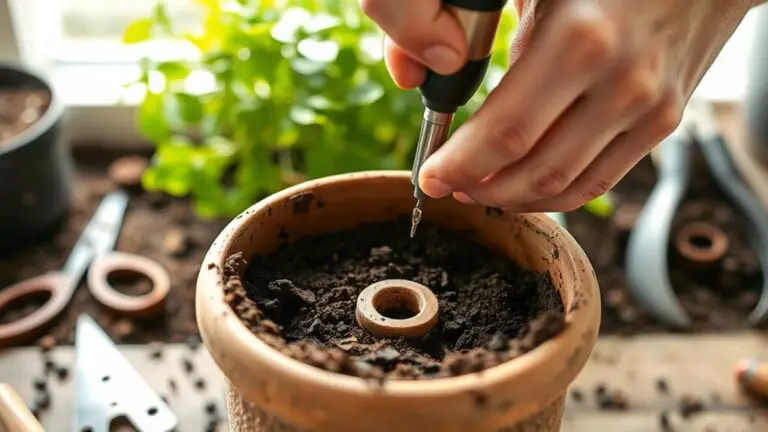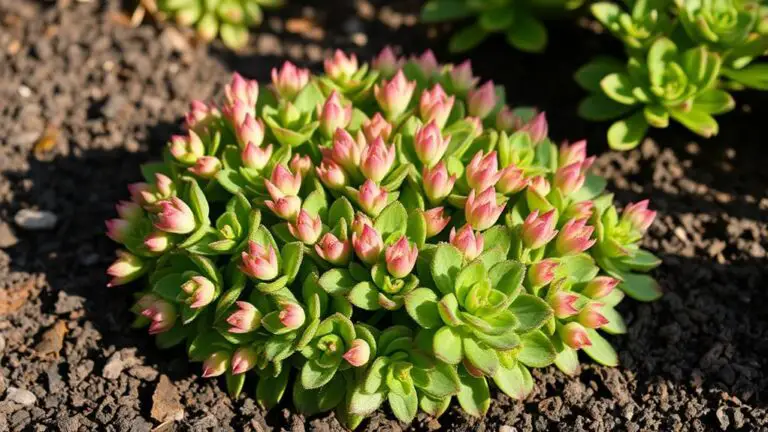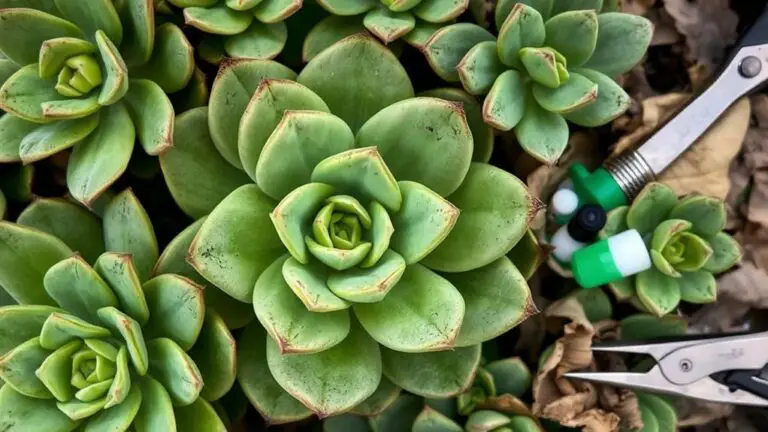10 Stunning Plants With Pink Foliage for Your Garden
If you're looking to add a splash of color to your garden, consider incorporating plants with pink foliage. These unique plants not only provide vibrant hues but also create striking contrasts with other greenery. With options like Coleus Pink Chaos and Sweet Potato Vine Pink Frost, your garden can transform into a vivid landscape. You'll also find that plants like Alternanthera Brazilian Red Hots and Gaura Flamingo Pink offer a variety of shades and textures. Curious about which other plants can elevate your garden's visual appeal? There are more spectacular choices you won't want to miss.
Coleus Pink Chaos

Coleus Pink Chaos, scientifically known as Coleus scutellarioides Pink Chaos, is a stunning plant that showcases bright fuchsia, green, and creamy white patterns, adding vibrant color to any garden.
You'll love how its pink foliage stands out, transforming any space into a visual delight. This plant thrives in full sun to shade conditions, making it highly adaptable to various garden settings and lighting environments.
Whether you have a sunny spot or a shadier corner, Coleus Pink Chaos fits right in. Growing to a height of 6-18 inches, it's perfect for both garden beds and container arrangements.
Its bright fuchsia and green foliage create a dynamic contrast that catches the eye and enhances your garden's appeal.
Living in USDA zones 10-11? This plant is ideal for you, thriving in those warmer climates.
Its versatility doesn't stop there; it's perfect for seasonal displays, allowing you to refresh your garden's look throughout the year.
From spring to fall, Coleus Pink Chaos keeps your garden vibrant and lively.
Sweet Potato Vine Pink Frost
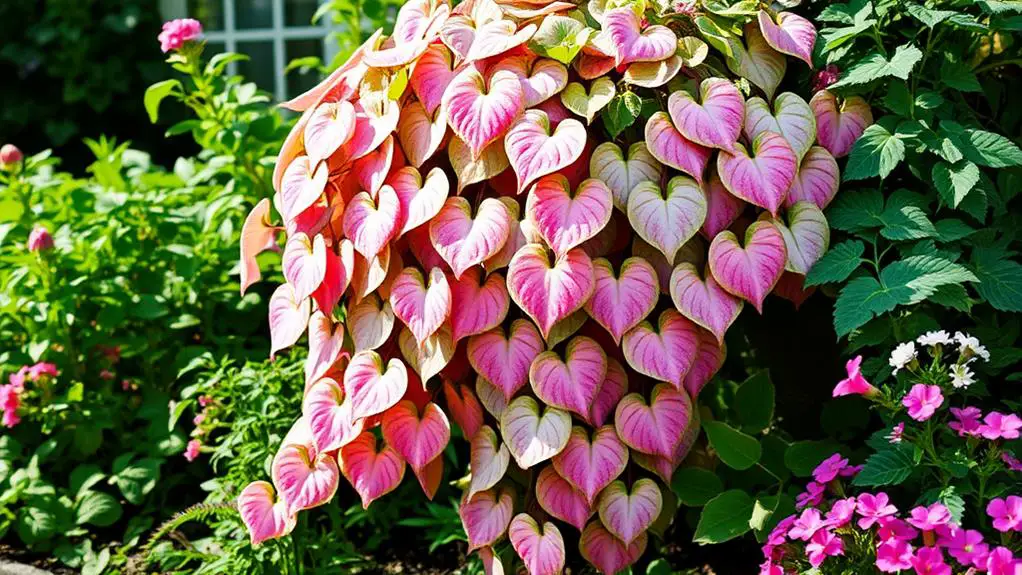
Sweet Potato Vine Pink Frost, scientifically known as Ipomoea batatas Pink Frost, dazzles with mint green leaves accented by creamy white and lilac variegation.
You'll love how these variegated leaves add a splash of color to your garden beds. This plant thrives in full sun to partial shade, reaching 1-2 feet in height. Its unique texture and stunning pink leaves make it a standout in any landscape.
To get the best out of your Sweet Potato Vine Pink Frost, here are some key points to keep in mind:
- Light Requirements: Performs best in full sun to partial shade.
- Height: Grows to about 1-2 feet, adding vertical interest.
- USDA Zones: Hardy in zones 9-11, ideal for warmer climates.
- Growth Habit: Less vigorous growth, perfect for a controlled display.
- Ornamental Appeal: Foliage color intensifies with adequate sunlight.
This beautiful vine isn't only hardy but also perfect for creating an elegant, controlled display in your garden beds or containers.
With its striking pink leaves and variegated foliage, Sweet Potato Vine Pink Frost will certainly enhance the ornamental appeal of your outdoor space. Embrace its vibrant beauty and watch your garden come to life!
Alternanthera Brazilian Red Hots

Among the enchanting plants with pink foliage, Alternanthera Brazilian Red Hots stands out with its vibrant magenta and red leaves. These stunning colors become even more pronounced when exposed to full sun.
You'll find that this plant thrives beautifully in garden beds and containers, making it a versatile choice for your garden.
Alternanthera Brazilian Red Hots grows well in USDA Zones 9-11, so it's perfect for warmer climates. If you live in one of these zones, you can enjoy a colorful display throughout the growing season.
The plant reaches a height of 1-3 feet, providing a striking contrast and enhancing the visual interest in your landscape. Its unique coloration adds depth to garden designs, creating a lively and eye-catching scene.
Although Brazilian Red Hots is primarily grown for its vibrant leaves, it may produce small flowers in the fall. However, these flowers are less prominent and don't detract from the plant's overall beauty.
To get the best color, place it in full sun or partial shade. With a little care, you'll find that Alternanthera Brazilian Red Hots is a fantastic addition to your garden, offering a burst of color and charm.
Gaura Flamingo Pink
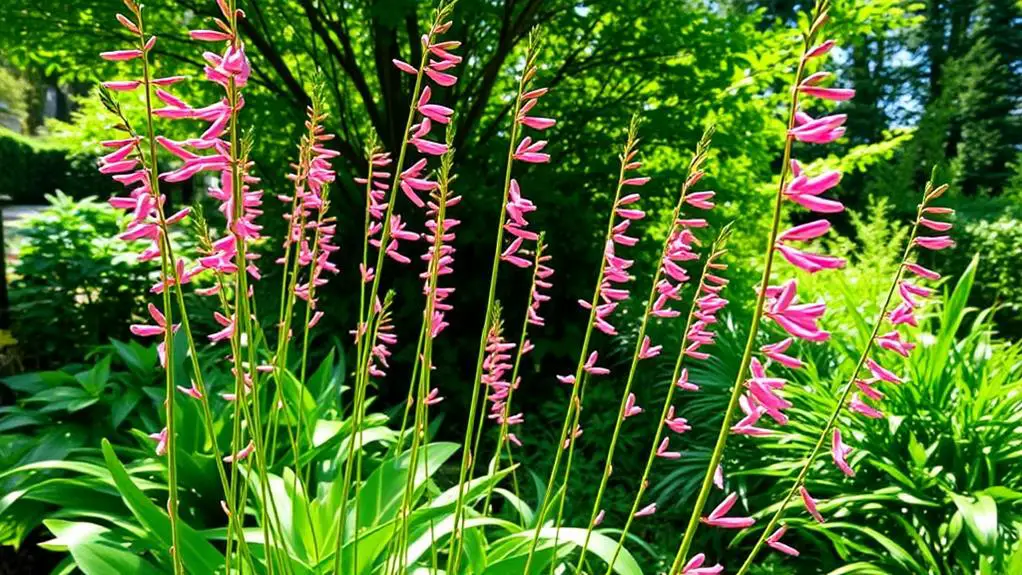
Continuing our exploration of plants with stunning pink foliage, let's turn our attention to Gaura Flamingo Pink. This charming perennial, also known as Gaura lindheimeri Flamingo Pink, will add a whimsical touch to your garden with its airy, delicate blooms.
Growing to a height of 1-3 feet, it thrives in full sun, making it an excellent choice for sunny garden beds.
The foliage of Gaura Flamingo Pink features reddish leaves that beautifully contrast with its bright pink flowers. This plant not only provides vibrant color from late spring through fall, but it also attracts pollinators like butterflies and hummingbirds, making your garden a lively place.
Gaura Flamingo Pink is hardy in USDA zones 4-9, so it can flourish in a variety of climates. Its long blooming period guarantees that your garden remains colorful for several months.
Here are some quick facts:
- Height: 1-3 feet
- Sunlight: Full sun
- Foliage: Reddish leaves
- Flowers: Bright pink
- Hardiness: USDA zones 4-9
With Gaura Flamingo Pink, you'll enjoy a garden full of vibrant color and visiting pollinators. It's a delightful choice for any gardener!
Hypoestes
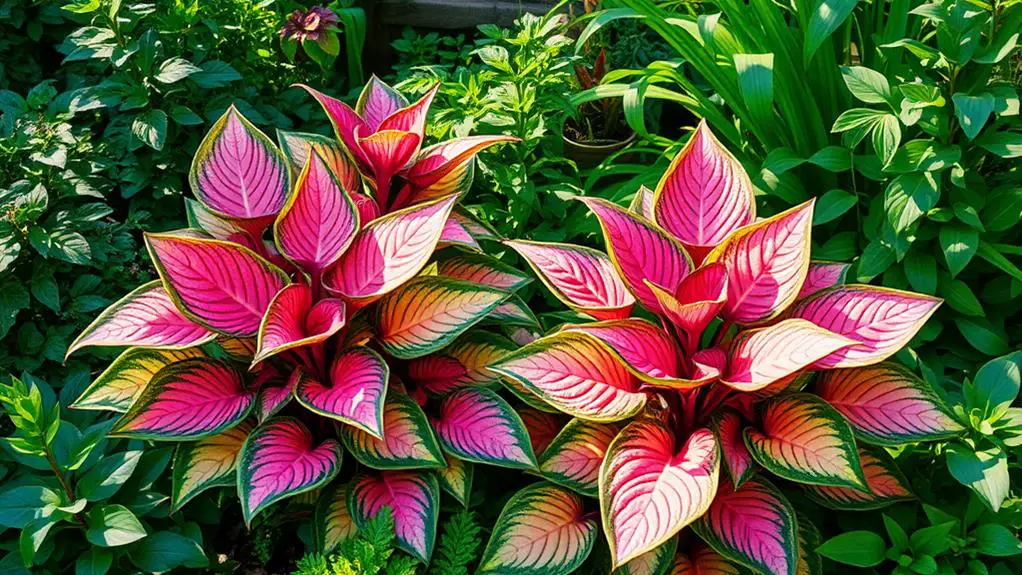
Hypoestes, commonly known as the Polka Dot Plant, offers a burst of color with its striking, speckled foliage. This plant features vibrant green and pink leaves that can brighten up any garden or indoor space. It typically grows to a height of 1-3 feet, making it perfect for containers and window boxes.
Hypoestes thrives in partial shade, so it's an excellent choice for areas that don't get a lot of direct sunlight. When it comes to watering, Hypoestes has low water needs. It enjoys consistently moist soil but make sure it doesn't get waterlogged.
This plant is hardy in USDA zones 10-11, meaning it prefers warmer climates and may not survive in colder areas. If you live in a cooler region, consider keeping your Hypoestes indoors where you can control its environment better.
Although it doesn't produce fragrant flowers, the beautiful pink foliage more than makes up for it. This plant does best in bright indirect light, which helps maintain its vivid colors.
With its unique and colorful appearance, Hypoestes adds a playful touch to your garden, and it's easy to care for. Happy planting!
Tiarella Heronswood Mist

Tiarella Heronswood Mist, with its low-growing stature, makes an excellent choice for ground cover and garden borders. This charming perennial reaches heights of 6-12 inches, making it perfect for filling in spaces and creating a lush, vibrant carpet in your garden.
Thriving in partial shade, it's hardy in USDA zones 5-7, adapting well to cooler climates.
You'll love the unique visual interest Tiarella Heronswood Mist brings to your garden. The fuzzy green leaves are adorned with creamy white speckles, adding texture and color from spring to fall.
In spring, delicate white flowers on slender stems appear, adding a soft, enchanting touch. As the weather cools, the blush shades of the leaves intensify, providing a delightful pink hue in summer and enhancing the plant's beauty into the fall months.
- Low-growing perennial: Reaches 6-12 inches in height
- Thrives in partial shade: Perfect for cooler climates
- Unique foliage: Fuzzy green leaves with creamy white speckles
- Seasonal blooms: Delicate white flowers in spring
- Color transformation: Leaves blush pink in summer and intensify in fall
Incorporating Tiarella Heronswood Mist into your garden guarantees year-round beauty and charm!
Heuchera Varieties

Heuchera varieties frequently captivate gardeners with their stunning foliage and adaptability, making them a favorite choice for adding color and texture to garden borders.
One standout, Heuchera Raspberry Ice, has ruffled leaves adorned with pink and silver tones. It reaches heights of 12-18 inches and thrives in partial shade, perfect for hardiness zones 4-9. This variety's pink foliage adds a vibrant color contrast to your garden, enhancing its overall aesthetics.
Another impressive option is Heuchera Pink Panther, which showcases deep berry-colored foliage that shifts to metallic tones. It can grow between 1-3 feet tall and adapts well to both full sun and full shade environments in zones 4-9. Whether you plant it in sunny spots or shadier areas, it will brighten your garden with its striking colors.
Both of these Heuchera varieties are ideal for garden borders and offer continuous visual interest throughout the growing season. They prefer well-drained conditions, so make sure your soil isn't too soggy.
Aside from their beautiful leaves, these plants produce delicate flower spikes that attract pollinators, adding functional beauty to your landscape. Enjoy your vibrant and dynamic garden with these stunning Heuchera varieties!
Phytolacca Pink Beauty

Phytolacca Pink Beauty, also known as Pink Beauty pokeweed, stands out with its unique pink berries that appear in late summer and early fall, adding a vibrant splash to your garden.
Growing to a height of 3-6 feet, it's perfect for borders and mixed plantings, thriving in full sun to partial shade.
This hardy plant, which attracts birds and other wildlife, requires well-drained soil and minimal maintenance once established, making it an excellent choice for various garden conditions.
Unique Pink Berries
Among the myriad of plants with enchanting foliage, few can rival the charm of those adorned with unique pink berries. Phytolacca Pink Beauty is one such plant that will add a touch of magic to your garden. Growing between 3 to 6 feet tall, this striking perennial thrives in USDA hardiness zones 5 to 9, so you can enjoy its beauty in various climates.
To help your Pink Beauty flourish, make certain you plant it in full sun or partial shade. It also requires well-drained soil to maintain its health and vibrant appearance. The lush green leaves provide a stunning backdrop for the unique pink berries that emerge in late summer, making the fruity season a visual treat.
Here's why you should consider adding Phytolacca Pink Beauty to your garden:
- Unique pink berries: They stand out against the green leaves.
- Attracting wildlife: Birds and butterflies love these berries.
- Full sun to partial shade: Flexible sunlight requirements.
- Well-drained soil: Guarantees healthy growth.
- USDA hardiness zones 5 to 9: Suitable for various regions.
Wildlife Attraction Benefits
You'll find that Phytolacca Pink Beauty isn't just a visual delight; it's a magnet for wildlife too. This plant's vibrant pink berries not only add a splash of color to your garden but also serve as a crucial food source for various birds and other wildlife. During late summer and early fall, when food can be scarce, these berries are especially appealing to animals.
Phytolacca Pink Beauty attracts pollinators like bees and butterflies, which helps boost the biodiversity of your garden ecosystem. The flowers and leaves provide both habitat and sustenance, supporting local wildlife and fostering a balanced environment.
By planting Phytolacca Pink Beauty, you're not just enhancing your garden's aesthetics but also contributing to the health of the local ecosystem.
As a native plant, Phytolacca Pink Beauty is particularly effective at supporting local wildlife. The combination of its striking pink berries and its ability to attract a variety of species makes it an excellent choice for a wildlife-friendly garden.
You'll love watching the birds and butterflies that visit, knowing that your garden isn't just beautiful but also a thriving, balanced ecosystem.
Growth and Care
Thriving in a range of climates, Phytolacca Pink Beauty can grow between 3 to 6 feet tall and is well-suited for USDA hardiness zones 5-9. This plant is versatile and adapts well to different garden settings.
To guarantee peak growth, here's what you need to know about its care:
- Light: Phytolacca Pink Beauty prefers full sun to partial shade. It's flexible, so it will thrive in various light conditions.
- Soil: Well-draining soil is essential. This prevents waterlogging, which can harm the roots.
- Watering: Regular watering is key, especially during dry spells. Keep the soil consistently moist but not soggy.
- Maintenance: This plant is relatively low-maintenance. It doesn't require frequent attention, making it perfect for busy gardeners.
- Pruning: Prune occasionally to control its size and encourage bushier growth. This helps keep your plant looking its best.
To promote those stunning pink berries that appear in late summer, guarantee your Phytolacca Pink Beauty is planted in the right spot.
Regular care will attract wildlife, like birds and pollinators, to your garden. With the right conditions, you'll enjoy a beautiful and vibrant addition to your garden that's easy to manage.
Caladium Varieties

Caladium varieties, frequently celebrated for their stunning, heart-shaped leaves, bring vibrant pinks and whites to shaded garden areas. Whether you're looking to add a pop of color to your garden beds or create a lush, tropical vibe, Caladiums are perfect.
Caladium Quick Facts
| Variety | Height | Light Needs | Colorful Features | USDA Zones |
|---|---|---|---|---|
| Pink Beauty | 18-22 in | Partial to Full Shade | Striking pink and white foliage | 9-11 |
| White Queen | 12-24 in | Partial Shade | White leaves with pink veins | 9-11 |
| Candidum | 12-24 in | Partial Shade | White foliage, green margins | 9-11 |
| Carolyn Whorton | 12-30 in | Full Shade | Pink leaves, green edges | 9-11 |
| Florida Sweetheart | 12-18 in | Partial Shade | Pink heart-shaped leaves | 9-11 |
Caladiums thrive in well-drained soil, so make sure your garden beds or containers don't hold too much water. Pink Beauty is a standout with its vibrant pink foliage, adding a splash of color to shaded spots. You'll find Caladiums are hardy in USDA zones 9-11, perfect for warmer climates. They grow beautifully in containers, making them easy to move around and show off.
Berberis and Nandina

When it comes to adding a touch of elegance and year-round interest to your garden, Berberis and Nandina are standout choices.
Berberis Rose Glow is a thorny shrub reaching 3-4 feet in height. Its variegated foliage features stunning pink and green tones, making it a colorful addition to your landscape. This hardy plant thrives in full sun to partial shade and is perfect for hardiness zones 4-8.
Nandina Domestica, also known as heavenly bamboo, is an evergreen shrub that can grow between 3-8 feet tall. Its foliage turns a beautiful pink in the fall, offering year-round interest in hardiness zones 6-9. This plant not only adds vibrant color but also produces white flowers that can turn into red berries in autumn.
Both Berberis and Nandina are adaptable and enhance landscape design with their vibrant color contrasts. They're great for hedging and screening due to their dense growth habits and colorful foliage.
- Berberis Rose Glow: Variegated pink and green foliage
- Nandina Domestica: Evergreen with pink fall foliage
- Hardy and adaptable plants
- Suitable for hedging and screening
- Adds colorful interest to the garden
Adding these shrubs to your garden will create a visually appealing and dynamic landscape!
Frequently Asked Questions
What Is the Plant With Pink Leaves Outside?
You're looking at a plant with pink leaves outside. It could be a Coleus Pink Chaos, Alternanthera Brazilian Red Hots, Heuchera Raspberry Ice, Bougainvillea, or Nandina Domestica. Each thrives in different light conditions and has unique characteristics.
What Flowers Look Good With Pink?
Pair pink flowers with cool-toned blooms like blue hydrangeas and purple salvia for harmony. Warm colors, such as yellow marigolds and orange zinnias, add vibrancy. Mixing pinks or combining them with white flowers creates fresh contrast.
What Is the Prettiest Pink Flower?
You might find the Cherry Blossom to be the prettiest pink flower. Its delicate petals and breathtaking spring display symbolize renewal and life's beauty. However, Peonies and Roses also offer stunning, fragrant pink blooms that captivate any garden.
What Perennial Plant Has Pink Spikes?
You should consider Gaura (Gaura lindheimeri). It's a perennial with pink spiky flowers on airy stems, blooming from late spring through fall. Thriving in full sun and hardy in USDA zones 4-9, it's also drought-tolerant.
Conclusion
Adding plants with pink foliage to your garden is a fantastic way to brighten up your outdoor space. You don't need to be an expert gardener to succeed. Start with Coleus Pink Chaos or Sweet Potato Vine Pink Frost for easy, vibrant options. Experiment with other plants like Heuchera or Caladiums to find your favorites. With a bit of care and patience, you'll create a stunning, colorful garden that you can be proud of. Happy gardening!


